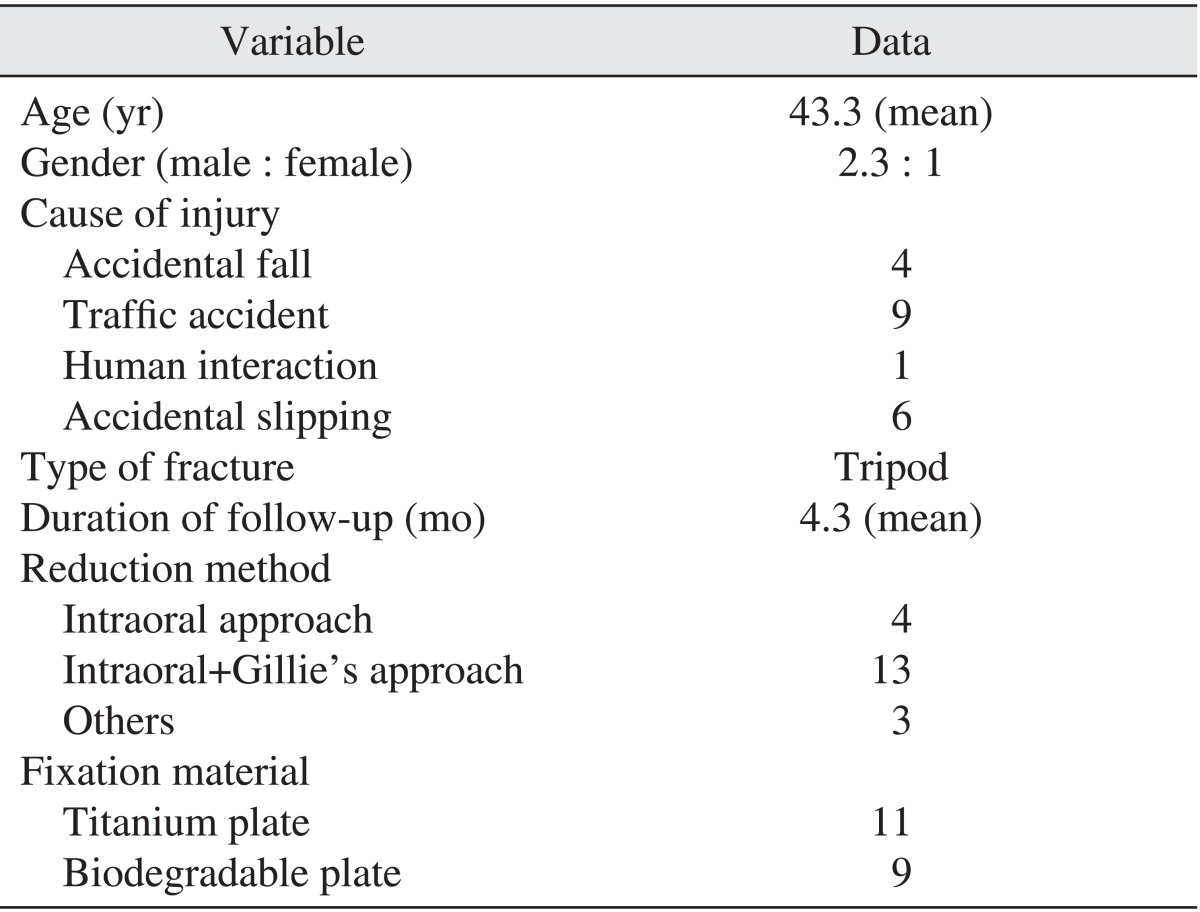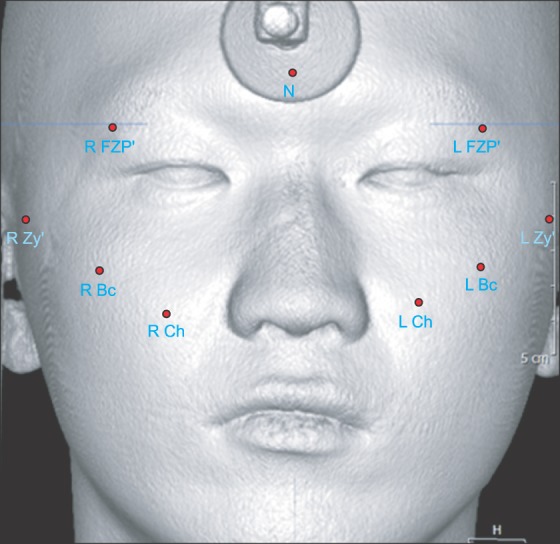1. Ellis E 3rd, Kittidumkerng W. Analysis of treatment for isolated zygomaticomaxillary complex fractures. J Oral Maxillofac Surg. 1996; 54:386–400. PMID:
8600255.

2. Chae YP, Kim SK. Clinical study on surgical treatment of zygoma fractures. J Korean Dent Assoc. 1989; 27:949–957.
3. Toriumi M, Nagasao T, Itamiya T, Shimizu Y, Yasudo H, Sakamoto Y, et al. 3-D analysis of dislocation in zygoma fractures. J Craniomaxillofac Surg. 2013; doi:
10.1016/j.jcms.2013.06.003.

4. Czerwinski M, Ma S, Williams HB. Zygomatic arch deformation: an anatomic and clinical study. J Oral Maxillofac Surg. 2008; 66:2322–2329. PMID:
18940500.

5. Zhang QB, Dong YJ, Guan JB, Li ZB, Zhao JH, Dong FS. Epidemiology and treatment of fractures of the zygomatic complex. Asian J Oral Maxillofac Surg. 2008; 20:59–64.

6. Ellis E 3rd, el-Attar A, Moos KF. An analysis of 2,067 cases of zygomatico-orbital fracture. J Oral Maxillofac Surg. 1985; 43:417–428. PMID:
3858478.

7. Gaziri DA, Omizollo G, Luchi GH, de Oliveira MG, Heitz C. Assessment for treatment of tripod fractures of the zygoma with microcompressive screws. J Oral Maxillofac Surg. 2012; 70:e378–e388. PMID:
22608820.

8. Miller L, Morris DO, Berry E. Visualizing three-dimensional facial soft tissue changes following orthognathic surgery. Eur J Orthod. 2007; 29:14–20. PMID:
16957060.

9. Solem RC, Marasco R, Guiterrez-Pulido L, Nielsen I, Kim SH, Nelson G. Three-dimensional soft-tissue and hard-tissue changes in the treatment of bimaxillary protrusion. Am J Orthod Dentofacial Orthop. 2013; 144:218–228. PMID:
23910203.

10. Baik HS, Jeon JM, Lee HJ. Facial soft-tissue analysis of Korean adults with normal occlusion using a 3-dimensional laser scanner. Am J Orthod Dentofacial Orthop. 2007; 131:759–766. PMID:
17561054.

11. Li H, Yang Y, Chen Y, Wu Y, Zhang Y, Wu D, et al. Three-dimensional reconstruction of maxillae using spiral computed tomography and its application in postoperative adult patients with unilateral complete cleft lip and palate. J Oral Maxillofac Surg. 2011; 69:e549–e557. PMID:
21982692.

12. Damstra J, Oosterkamp BC, Jansma J, Ren Y. Combined 3-dimensional and mirror-image analysis for the diagnosis of asymmetry. Am J Orthod Dentofacial Orthop. 2011; 140:886–894. PMID:
22133955.

13. Cavalcanti MG, Rocha SS, Vannier MW. Craniofacial measurements based on 3D-CT volume rendering: implications for clinical applications. Dentomaxillofac Radiol. 2004; 33:170–176. PMID:
15371317.

14. Park SH, Yu HS, Kim KD, Lee KJ, Baik HS. A proposal for a new analysis of craniofacial morphology by 3-dimensional computed tomography. Am J Orthod Dentofacial Orthop. 2006; 129:600.e23–600.e34. PMID:
16679198.

15. You KH, Lee KJ, Lee SH, Baik HS. Three-dimensional computed tomography analysis of mandibular morphology in patients with facial asymmetry and mandibular prognathism. Am J Orthod Dentofacial Orthop. 2010; 138:540.e1–540.e8. PMID:
21055584.

16. Lee MS, Chung DH, Lee JW, Cha KS. Assessing soft-tissue characteristics of facial asymmetry with photographs. Am J Orthod Dentofacial Orthop. 2010; 138:23–31. PMID:
20620830.

17. Baik HS, Kim SY. Facial soft-tissue changes in skeletal class III orthognathic surgery patients analyzed with 3-dimensional laser scanning. Am J Orthod Dentofacial Orthop. 2010; 138:167–178. PMID:
20691358.

18. Meyer-Marcotty P, Alpers GW, Gerdes AB, Stellzig-Eisenhauer A. Impact of facial asymmetry in visual perception: a 3-dimensional data analysis. Am J Orthod Dentofacial Orthop. 2010; 137:168.e1–168.e8. PMID:
20152669.

19. Peck S, Peck L, Kataja M. Skeletal asymmetry in esthetically pleasing faces. Angle Orthod. 1991; 61:43–48. PMID:
2012321.
20. Ferrario VF, Sforza C, Poggio CE, Serrao G. Facial three-dimensional morphometry. Am J Orthod Dentofacial Orthop. 1996; 109:86–93. PMID:
8540488.

21. Furst IM, Austin P, Pharoah M, Mahoney J. The use of computed tomography to define zygomatic complex position. J Oral Maxillofac Surg. 2001; 59:647–654. PMID:
11381388.

22. Gwilliam JR, Cunningham SJ, Hutton T. Reproducibility of soft tissue landmarks on three-dimensional facial scans. Eur J Orthod. 2006; 28:408–415. PMID:
16901962.

23. Cho HJ. A three-dimensional cephalometric analysis. J Clin Orthod. 2009; 43:235–252. PMID:
19458456.
24. Modabber A, Rana M, Ghassemi A, Gerressen M, Gellrich NC, Hölzle F, et al. Three-dimensional evaluation of postoperative swelling in treatment of zygomatic bone fractures using two different cooling therapy methods: a randomized, observer-blind, prospective study. Trials. 2013; 14:238. PMID:
23895539.

25. Hwang HS, Yuan D, Jeong KH, Uhm GS, Cho JH, Yoon SJ. Three-dimensional soft tissue analysis for the evaluation of facial asymmetry in normal occlusion individuals. Korean J Orthod. 2012; 42:56–63. PMID:
23112933.

26. Zachariades N, Mezitis M, Anagnostopoulos D. Changing trends in the treatment of zygomaticomaxillary complex fractures: a 12-year evaluation of methods used. J Oral Maxillofac Surg. 1998; 56:1152–1156. PMID:
9766540.

27. Kubota Y, Kuroki T, Akita S, Koizumi T, Hasegawa M, Rikihisa N, et al. Association between plate location and plate removal following facial fracture repair. J Plast Reconstr Aesthet Surg. 2012; 65:372–378. PMID:
22030077.

28. Klotch DW, Gilliland R. Internal fixation vs. conventional therapy in midface fractures. J Trauma. 1987; 27:1136–1145. PMID:
3312622.

29. Alpert B, Tiwana PS, Kushner GM. Management of comminuted fractures of the mandible. Oral Maxillofac Surg Clin North Am. 2009; 21:185–192. PMID:
19348983.

30. Ferrario VF, Sforza C, Schmitz JH, Miani A Jr, Serrao G. A three-dimensional computerized mesh diagram analysis and its application in soft tissue facial morphometry. Am J Orthod Dentofacial Orthop. 1998; 114:404–413. PMID:
9790324.

31. af Geijerstam B, Hultman G, Bergström J, Stjärne P. Zygomatic fractures managed by closed reduction: an analysis with postoperative computed tomography follow-up evaluating the degree of reduction and remaining dislocation. J Oral Maxillofac Surg. 2008; 66:2302–2307. PMID:
18940496.

32. Wittwer G, Adeyemo WL, Yerit K, Voracek M, Turhani D, Watzinger F, et al. Complications after zygoma fracture fixation: is there a difference between biodegradable materials and how do they compare with titanium osteosynthesis? Oral Surg Oral Med Oral Pathol Oral Radiol Endod. 2006; 101:419–425. PMID:
16545702.

33. Langford RJ, Frame JW. Tissue changes adjacent to titanium plates in patients. J Craniomaxillofac Surg. 2002; 30:103–107. PMID:
12069513.

34. Dal Santo F, Ellis E 3rd, Throckmorton GS. The effects of zygomatic complex fracture on masseteric muscle force. J Oral Maxillofac Surg. 1992; 50:791–799. PMID:
1634969.

35. Choi BK, Goh RC, Moaveni Z, Lo LJ. Patient satisfaction after zygoma and mandible reduction surgery: an outcome assessment. J Plast Reconstr Aesthet Surg. 2010; 63:1260–1264. PMID:
19703797.

36. Zheng W, Xiang L, Fadare O, Kong B. A proposed model for endometrial serous carcinogenesis. Am J Surg Pathol. 2011; 35:e1–14. PMID:
21164282.










 PDF
PDF ePub
ePub Citation
Citation Print
Print






 XML Download
XML Download